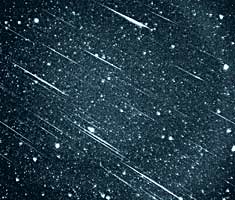
On the morning of November 17, 1966, skywatchers in western North America were spellbound by an awesome flood of Leonid meteors peaking around 5 a.m. Mountain Standard Time. It was probably the greatest meteor shower of the 20th century. At New Mexico State University Observatory, A. Scott Murrell used a camera tracking the stars to capture this 10- to 12-minute exposure with a 50-mm f/1.9 lens and Kodak Tri-X (ISO 400) film. The bowl of the Little Dipper is at bottom.
Photo by A. Scott Murrell/NMSU; courtesy Sky & Telescope.
As most Sky & Telescope readers know, the Leonids are the dross of Comet 55P/Tempel-Tuttle. A meteor stream is like an enormous highway of moving particles, strung out along the entire elliptical path of the comet, and we become aware of only those particles that actually encounter our planet (a comparatively tiny target — a mere dot in space). The geometry of the encounter makes them appear around November 18th each year from the direction of the Sickle of Leo, hence the name "Leonids." We normally see no more than about 10 meteors per hour.
But that’s just an average Leonid shower. Every third of a century, for several Novembers in a row, there is the chance that the Leonids will put on a truly prolific showing. There can be hundreds or even thousands of shooting stars per hour. In fact, we are in this window of potential Leonid storms right now. Each time Comet Tempel-Tuttle sweeps through the inner solar system and passes nearest to the Sun, it spews new sets of particles into space that quickly elongate into long, narrow, extradense ribbons of debris. Such ribbons of meteoroids likely have a complex structure and almost certainly contain denser sheets or clusters, each perhaps spawned by an individual outburst on the comet nucleus. A typical dust trail must be at least several astronomical units (Earth-Sun distances) long to have been encountered for several years running, but it is probably only a few Earth diameters thick.
Leonids appear ultrafast compared to the meteors of other showers, for this stream’s particles enter our atmosphere at 71 kilometers per second (near the theoretical speed limit for particles belonging to our solar system). Because of their tremendous speeds, Leonids can be extremely bright and are often tinged with hues of blue or green. Roughly half leave luminous vapor trains — some hanging in the air five minutes or more.
The curtain on the current Leonid saga rose in November 1998, just eight months after Comet Tempel-Tuttle passed perihelion. On the night of November 16–17 that year, practically the whole world witnessed a remarkable and unexpected 18-hour bombardment of brilliant fireballs, at times numbering up to a few hundred per hour. In 1999 fewer fireballs were seen, but they were replaced by a true storm of more typical Leonids with rates reaching one per second over Europe, Africa, and the Middle East. A very good display (but no storm) appeared in 2000. Then in 2001, not one but two Leonid storms materialized.
And now, in 2002, we prepare for what indeed will be the grand finale. It’s one final opportunity to see Leonid displays capable of producing rates in excess of 1,000 per hour — one last chance, for probably a very long time, to see a Leonid storm.
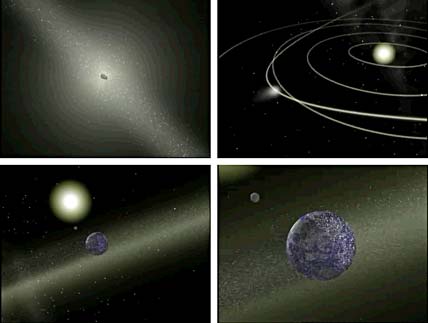
As it nears the Sun every 33 years, the icy nucleus of Comet Tempel-Tuttle ejects a flurry of small particles, which spread out along its orbit over time. Earth crosses this stream of comet crumbs every November, creating a 'shower' — and rarely a 'storm' — of meteors in our atmosphere. These frames come from an animation; click on the image to download a 2-megabyte QuickTime movie.
Animation by Don Davis; courtesy Sky & Telescope.
Leonid Guide for 2002

The Lyytinen Leonid model predicts two peaks in 2002. The first should reach a ZHR of 3,500 centered at 4:03 UT on November 19th. According to Esko Lyytinen’s calculations, this part of the display (due to the 1767 dust trail) should be above half strength for a period lasting 106 minutes. The second peak should attain a ZHR of 2,600 at 10:46 UT, with a corresponding duration of 122 minutes. Thus the second peak should last slightly longer, even though it's due to the fresher, 1866 dust trail.
Source: Esko Lyytinen / URSA.
By far the best forecasts of Leonid outbursts during the past three years, in terms of intensity and timing of peak activity, have been those issued by Esko Lyytinen of the astronomical society URSA in Finland and Thomas Van Flandern of Meta Research, Washington, D.C. Last year, for example, Lyytinen’s Leonid model came within just 1 minute of anticipating the maximum of the nine-revolution trail, 4 minutes for the four-revolution trail, and 11 minutes for the seven-revolution trail. The 2002 Leonid predictions have been improved with the assistance of Markku Nissinen, also of URSA.
Equally well known for their past Leonid forecasts are David Asher of Armagh Observatory in Northern Ireland and Robert McNaught of the Australian National University and Siding Spring Observatory. Several years ago they developed their now-famous "dust trail" model of how meteor streams evolve in space. This model received worldwide acclaim after it predicted the peak of the 1999 Leonid storm to within only 6 minutes.
Based on past track records, we feel that the Lyytinen and Asher models will serve as our best guides to how strong the Leonids will become in 2002 and when these peaks in activity will occur.
It turns out that the older four- and seven-revolution dust trails, which performed so well in 2001, are to be encountered one last time in 2002. This set of circumstances holds promise for producing not only large numbers of meteors, but also many bright ones. As we have already suggested, the drawback for all prospective Leonid observers this year — and it will be a huge one — will be the Moon. It will be only hours from reaching full phase, making observing conditions the worst possible! For every magnitude step of naked-eye stars hidden by bright moonlight or light pollution, the number of meteors is cut by roughly 60 percent. Thus, if your limiting magnitude is 4.0, you will see only one tenth the meteors you would see if it were 6.5. But, as we’ll explain later, moonlight may not be as grim a hindrance as it first seems.
A Pair of Storms
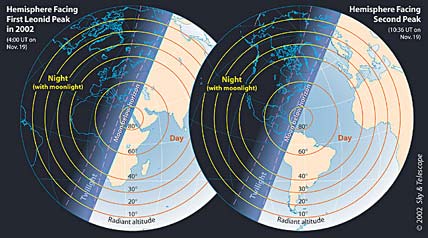
Like giant targets in space, these views show how Earth will be facing incoming Leonid particles during each of the 2002 peaks. Meteors will be visible from regions to the left during nighttime or some stage of twilight. The moonset curve, dashed, appears very near that for sunrise because the Moon is full. Concentric curves indicate the apparent altitude of the radiant, taking into account the 'zenithal attraction' effect, whereby Earth’s gravity bends meteoroids’ paths slightly during their final approach. These plots, adapted from those by Robert McNaught, show the hemispheres at the Asher model’s peak times; these differ by just minutes from those given by the Lyytinen model (see text).
Source: Robert H. McNaught.
Storm No. 1. The seven-revolution trail will be encountered first. There is excellent agreement between the Asher and Lyytinen models as to the time when peak activity should occur. The peak is forecast to occur at 4:00 and 4:03 Universal Time, respectively, on November 19th.
The Lyytinen model forecasts a zenithal hourly rate (ZHR) of 3,500 for this particular trail, as shown in the diagram on the previous page. (The ZHR is the number of meteors that a single observer would see if the radiant were at the zenith in a sky dark enough for 6.5-magnitude stars to be seen. Actual conditions are rarely this good.) The Asher model, however, provides two possible values for this trail (a ZHR of 1,000 to 3,000). Both models also indicate that the seven-revolution dust trail responsible for this first storm will be the richer in bright meteors.
As can be seen in the left-hand diagram above, western Africa as well as western and central sections of Europe are the favored viewing locations. The region that offers the most promise appears to be a strip of northwest Libya (near Tripoli) as well as the adjacent coast of the Mediterranean Sea, where the Leonid radiant will climb to at least 70° altitude while the bright Moon hangs low over the western horizon. Morning twilight will begin very shortly thereafter.
But wait! Take a closer look at the visibility map. Notice that near the upper-left edge, just protruding into view, are the Maritime Provinces of Canada and the northeastern sections of New England. Here the Leonid radiant will be rising into view above the east-northeast horizon just as the Leonids generated by the 1767 trail reach their peak. This special circumstance could lead to the appearance of Earth-grazing meteors, due to meteoroids that skim through our atmosphere along a path nearly parallel to Earth's surface.
If this first peak really occurs near 4:00 UT on November 19th, it is not out of the question that a brief bevy of Earth-grazing Leonids may be visible from parts of New England and eastern Canada. Keep in mind that for New England this peak is due on the previous calendar day; November 18th locally, at about 11:00 p.m. Eastern Standard Time. For Atlantic Canada, the corresponding time is midnight, and for Newfoundland it's 12:30 a.m. on the 19th. Unfortunately, the Moon will be near its highest point in the southern sky around this time as well.
Storm No. 2. The 1866 (four-revolution) trail is expected to arrive about 6½ hours after the 1767 trail. During that interval, Earth will have rotated to bring much of North America into the prospective viewing zone. As to intensity, the Lyytinen model forecasts a ZHR of 2,600, while the Asher model predicts 3,500. There is again excellent agreement between the two teams as to the time when peak activity should occur; Asher and McNaught cite 10:36 UT, while Lyytinen and Van Flandern give 10:46 UT.
The right-hand Earth view (above) shows that virtually all of North America will be favored. Only near and along the Atlantic Seaboard will advancing morning twilight be an issue. The farther east one goes, the brighter the dawn sky will be. Even so, all viewers are well advised to keep a Leonid watch right up through sunrise, since at past Leonid outbursts brilliant fireballs have been perceived in bright twilight, even broad daylight.
The Moon in 2002
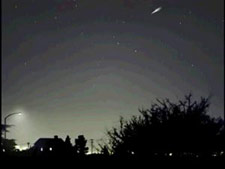
Simulation of a rich Leonid meteor shower as seen in a light-polluted night sky in a moonlit and/or heavily populated area. Only a few bright meteors show through; the faint ones are hidden by skyglow. The video illustrates how all members of the shower appear to radiate from the same direction in the sky (in the constellation Leo). Click on the image to download a (600-kilobyte QuickTime animation).
Animation by Don Davis; courtesy Sky & Telescope.
During the 2000 Leonids a last-quarter Moon stood less than 10° southwest of the Leonid radiant, greatly hindering viewers. In 2002 the Moon will be full and thus about 10 times brighter, but it will also be 10 times farther away from the Leonid radiant (about 100° away, in eastern Aries). Moreover, in eastern North America where this second peak is forecast for near the break of dawn, the Leonid radiant will stand high in the south-southeast as the Moon sits low toward the western horizon. In the Florida Panhandle, observers near Tallahassee can expect maximum Leonid activity as the radiant appears at its highest, just over 70° up, as morning twilight sets in.
No More Stormy Times Ahead
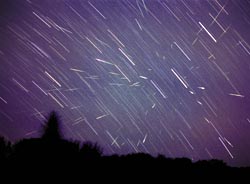
Patricia Totten captured dozens of brilliant meteors during the height of 2001’s second Leonid storm. Notice how their tracks appear to emanate from roughly the same direction, or radiant, in the eastern sky. Since her Nikon FG camera was fixed on a tripod during the 15-minute exposure, stars appear as short trails. The picture was made at Ayers Rock, Australia. Totten used a 50-millimeter lens at f/2 and Fuji Superia 800 film.
After 2002, however, there will be no more Leonid storms for a very long time. Donald K. Yeomans of NASA’s Jet Propulsion Laboratory as well as Brian G. Marsden and Gareth V. Williams at the Minor Planet Center in Cambridge, Massachusetts, have calculated the path of 55P/Tempel-Tuttle through future perturbations. They all find that as the comet approaches the Sun toward a May 2031 perihelion, it will pass within 1.5 a.u. of Jupiter in August 2029. This encounter will push the comet closer to the Sun and increase the distance between Earth’s orbit and the comet’s to 0.0162 a.u. — their largest separation since 1733. Such a large gulf between the two orbits may preclude any substantial meteor activity for the year 2031, and for several years thereafter, when the next cycle of Leonid storms would normally be expected.
In examining this next Leonid cycle, McNaught has found three outlying dust trails that the Earth will approach in the years 2033 and 2034. "Unfortunately," he notes, "they are probably too distant for any reasonable chance of high activity."
There will be little improvement at the comet’s subsequent return in 2065, for the separation between the orbits of the comet and the Earth will have diminished only slightly to 0.0146 a.u.
In 2098 the separation of the orbits shrinks to 0.0062 a.u. And in 2131, for the first time since 1633, the comet crosses our orbital plane slightly outside the Earth’s orbit at a distance of 0.0089 a.u. Not until one, or both, of these remote years can our great grandchildren expect to witness a storm of Leonid meteors.
 0
0
Comments
You must be logged in to post a comment.